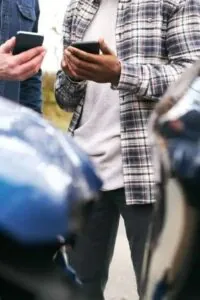This highway, parts of which date back to the horse-and-buggy days of 1912, was designed to be Ohio’s back road. For many decades, that was the case. State Route 4 runs from Sandusky to Cincinnati. Between the two, it passes through mostly small towns. Today, the traffic on State Route 4, both in terms of volume and speed, far exceeds the original design specifications. That is especially true of the northern half, which is mostly a two-lane highway.
The northern part of State Route 4, with its potential for devastating head-on collisions, is not the only dangerous part. This former back road is the primary route between Columbus and Cincinnati when Interstate 71 backs up, as it often does. The combination of impatient drivers and stop-and-go traffic is often deadly. More on some common car crash injuries below.
Back road collisions create unique legal issues as well. For example, smaller counties, like Butler, Champaign, and Clark County, usually have their own way of doing things. Furthermore, these jurors are often openly hostile to “big-city lawyers.” So, a State Route 4 crash victim needs a Preble County personal injury lawyer who’s familiar with all these intricacies. Inexperienced lawyers rarely obtain maximum compensation in these situations.
What Causes State Route 4 Crashes?
As mentioned, inattentive driving is usually the biggest problem south of Columbus. Aggressive driving causes most of the wrecks north of Columbus.
Distraction might be the most common kind of driver impairment. Most people safely and efficiently multitask their way through their days. So, they assume they can do the same thing behind the wheel.
Multitasking is usually a good idea in static, or relatively static, office, home, and school environments. Multitasking behind the wheel is usually a bad idea. Multitaskers have no control over most variables.
Distraction clearly violates the duty of care, which requires drivers to focus on the road when driving. Other kinds of distraction include:
- Alcohol: A decades-long drunk driver crackdown has significantly decreased the number of intoxicated and impaired drivers. Pandemic lockdowns erased much of that progress. When roads emptied and traffic enforcement ceased, many drivers lapsed back into old habits, such as drinking and driving.
- Drugs: Issue 2, a proposal to legalize recreational marijuana in Ohio, looks like it will pass in November 2023. However, changing its legal status does not change marijuana’s medical status. This drug impairs judgment and motor skills, making it impossible to safely operate a motor vehicle.
- Medical Condition: Moderate illnesses, like severe seasonal allergies or a cold or flu virus, diminish driving ability by as much as 50%. People are not at their physical best when they are sneezing and coughing. More severe medical conditions, like diabetes and epilepsy, could trigger sudden loss of consciousness behind the wheel.
- Extreme Fatigue: Most drivers admit that drowsy driving is dangerous. The effects of fatigue are similar to the effects of alcohol. Yet most drivers admit they have operated motor vehicles while seriously fatigued. In fact, a significant number admit they have literally fallen asleep at the wheel.
If driver impairment or another breach of duty substantially causes injury, a Preble County personal injury lawyer can obtain compensation for economic loss, such as medical bills, and noneconomic losses, such as pain and suffering.
Aggressive driving is the most common breach in Ohio. Some examples of dangerous aggressive driving include:
- Speeding too fast for the conditions,
- Turning unsafely,
- Tailgating,
- Passing unsafely, and
- Braking quickly.
Note that most, but not all, of these aggressive driving behaviors violate safety laws. If a safety law violation substantially causes a wreck, the tortfeasor (negligent driver) could be liable for damages as a matter of law.
Also, note that there is a difference between substantial cause and sole cause. Wet roads, thick fog, driving snow, and other adverse environmental conditions often contribute to State Route 4 car crashes. But these conditions do not substantially cause wrecks, at least in most cases. If Bill loses control of his car on a slick road, he was most likely driving recklessly to begin with.
For a free legal consultation, call 513-894-3333
Vehicle Collision Injuries
Speed limits are much higher on state highways than on side streets. Since velocity multiplies the force in a collision between two objects, state highway crashes usually cause serious injuries, such as:
- Broken Bones: During high-speed crashes, victims’ arms and legs usually bang against dashboards or other solid objects. The resulting impact usually breaks these bones in multiple places. As a result, doctors cannot completely restore them. Instead, these victims usually suffer from permanent pain and/or loss of motion.
- Internal Injuries: Seat belts and airbags often prevent some broken bones, like a broken pelvis or broken ribs. But they do not prevent the organs these bones protect, like the kidneys and lungs, from jostling against each other. The slightest abrasion often gushes blood, since these organs do not have protective skin linings.
- Head Injuries: The same analysis applies to head injuries. Airbags and seat belts prevent some head trauma injuries. But they do not keep the brain from slamming against the inside of the skull. The resulting impact usually causes brain bleeding and swelling. These injuries intensify and kill tens of thousands of Americans every year.
Despite the high traffic, State Route 4 is still a back road in many ways. Therefore, the closest trauma center usually is not very close. So, by the time doctors treat victims, serious injuries have usually escalated into catastrophic (life-threatening) injuries.
Additionally, since adrenaline masks pain, many victims tell first responders they “feel fine.” So, emergency responders do not aggressively treat these victims.
Treatment delays have legal consequences as well as medical consequences. If victims do not immediately see doctors, or doctors do not immediately treat them, insurance company lawyers often argue the victim’s injuries are exaggerated.
Vehicle Collision Medical Bills
The combination of severe injuries and treatment delay usually means the victim’s medical bills exceed $40,000. Back road highway injuries often increase these medical bills at several points in the process.
Let’s start with transportation expenses. Emergency responders often airlift car crash victims to hospitals. Or, doctors airlift them from a small local hospital to a large regional trauma center. A few minutes in a medevac helicopter could cost more than $40,000. Therefore, in some cases, the ride to the hospital is more expensive than the hospitalization itself.
Next, insurance company adjusters typically use generic tables to determine medical bill compensation. But, as outlined above, a broken arm in a semi-rural area is much more expensive to treat than a broken arm in a large urban area.
Severe injuries usually also mean longer and more intense physical therapy. Furthermore, in many cases, victims do not progress at a steady rate. Sudden breakthroughs often follow weeks or months of little improvement.
A Preble County personal injury attorney advocates for victims during physical therapy, so the insurance company funding continues to flow.
Click to contact our lawyers today
Obtaining Compensation
Medical bills are usually the largest component of damages in a car crash case. So, once medical treatment is at least substantially complete, a Preble County personal injury lawyer can determine a claim’s settlement value.
New cars have sticker prices and car crash claims have settlement values. The sticker price is the combined cost of all vehicle parts, like the car itself plus extras, like air conditioning, cruise control, and rear AC. The settlement value is also a combination of economic and noneconomic losses.
In addition to medical bills, economic losses include property damage and lost wages. Noneconomic losses, such as pain and suffering, don’t have a price tag. So, an attorney usually multiplies the economic losses by two, three, or four, mostly depending on the facts of the case.
No one pays the sticker price for a car and no insurance company pays the full settlement value to resolve a personal injury case. In both situations, there is some give and take. Attorneys, who are good negotiators, help ensure that the insurance company does most of the giving and the victim does most of the taking.
Complete a Free Case Evaluation form now
Count on a Determined Ohio Injury Lawyer
Injury victims are entitled to substantial compensation. For a free consultation with an experienced personal injury lawyer in Ohio, contact Kruger & Hodges, Attorneys at Law by going online or calling 513-894-3333.
Call or text 513-894-3333 or complete a Free Case Evaluation form






